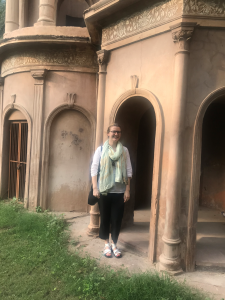
Inside Sikander Bagh
در دوران نیمه دوم اقامت من در کلیه ها تنگ شهر لکهنو گشته ام و به جایگاهها تاریخی خیلی جالب سرگردان ام . این شهر یک قسمت مخصوص دل من دارد . امیدوارم که خواهم برگشتن .
یکی از صورت های یکتا مراسم معماری شهر لکهنو اِمام باڑاها هستند . یعنی حسینی به زبان فارسی ایرانی . این ساختمان ها مهم فرهنگ عزاداری خصوصا آسیا جنوبی نشان می دهند . نواب ها لکهنو حامی اِمام باڑاها بودند . به سبب کارها آنها , بناها عزاداری و یاد گر شهیدها کربلا یکی از قسمتها قابل توجه زندگی شهری اینجا شد . با اينكه من اینجا نبوده ام درمیان ماه محرم , من هنوز به چندین اِمام باڑاها دید و بازدید کردم .
شاه نجف است, که در 1816 ساخته شده بود. بنا به کناره رودخانه گومتی واقع شده است . فرمان ساخت این ازنواب غازی الدیں حیدر شاہ آماده است , که آخرین وزیر و اولین شاه اوده بود . نواب غازی الدیں حیدر برایه چندین بنا های معروف در محله کناره گومتی عهده دار٫ مثل موتی محل , چھتر منزل و مقبره پدرش سعادت علی خان که امروزه یک باغ در قیصرباغ است . این همه ساختمانها نزدیک رودخانه بودند در یک جایگاه بودند . اِمام باڑا چندین بخش هستند .
یک مسجد کوچک است , قدم رسول است , که نقش پا رسول است , و اِمام باڑا خود . در اِمام باڑا , چهار مقبره هستند : قبر نواب , قبر همسرش که انگلیسی بود , قبر همسر دوم و قبر همسر کوچکترین .این بنا نسخه مقبره حضرت علی در شهر نجف در عراق است . آرامگاه دور و بر بخش خاک نجف ساخته شده است . به این وسیله مردم شهر بی سفر به عراق هنوز زیارت توانسته بودند.
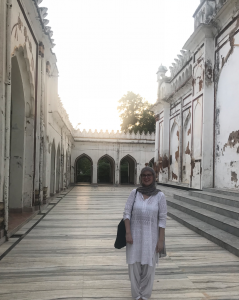
At the Shah Najaf Imambara
در داخل بنا چندین چیزها با اهمیت برای مراسم ها عزاداری هستند . دو منبر هستند , یک بیرون آرامگاه و یک داخل آن . منبر اول دوران محرم حمل کرده است در دسته ها شهر . دوران جلوس , خوانده روضه روی منبر دوم می ایستاد . در سراسر ساختمان , چراغها خیلی زیبا که غازی الدیں حیدر از بلژیک را آورد آویزان بوده هستند . امروزه چراغها برقی شده هستند و به نهم دهم و یازدهم محرم به اِمام باڑای بزرگی آورده می شوند .
من به سبطین آباد اِمام باڑا را که بسیار جالب است باز دید کردم که در محله حضرتگنج واقع شده است . سبطین آباد اِمام باڑا در1847 سفارش شده بود توسط وجد علی شاه درسال تاجگذاری اش . این ساختمان یک جایگاه عزاداری بودند دوران زمانه اش و هم امروزه بعد از ترمیم بنا محل دادرسی ماتم خاص است . این ساختمان موثر فقط عبادت خانه نیست . در آن جا مقبره نواب امجد علی شاه است .
داخل بنا مناظر خیلی خوب صورت است . روی دیوارها نقشی سبز رنگ زده است . رنگ آمیزی بسیار نازک در بین است . آینه ها و لوسترها شیشه درخشیدند . در سال 1858 سربازها ارتش انگلیسی اِمام باڑا را حمله کرد و کناره ساختمان خراب شده بود . بعد از آن در زمانه حکومت انگلیسی اِمام باڑا کلیسا شد . به تازگی , در سال .2013 , اِمام باڑا تعمیر شده بو
جایگاه ها لکهنو مثل این دو منحصر به این شهر است خاص نشان عزاداری می دهد که ساخته شده است در معماری منحصر این شهر . امروزه زمانه نواب ها افته شده است ولی این رسم ها زنده هستند در این جایگاه ها .
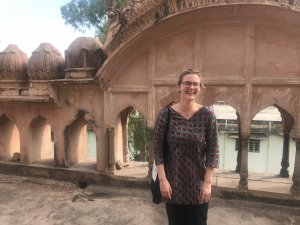
On the roof of the tomb of Saadat Ali Khan
English:
In the second half of my stay, I went around the narrow lanes of the city in Lucknow and visited its very interesting historic places. This city has a special place in my heart. I hope I will return.
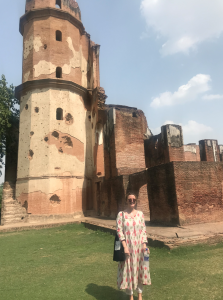
At the British Residency
One of the most important aspects of the architectural tradition of the city of Lucknow are ‘imambaras’ (which are called Husseinis in Iranian Persian). These important buildings demonstrate the special culture of (Shia) mourning in South Asia. The Nawabs of Lucknow were patrons of the imambaras. Because of their actions, buildings for mourning – the remembrance of the martyrs at Karbala – became a very significant part of civic life here. While I have not been here during the (commemorative) month of Muharram, I still saw and looked around some imambaras.
The Shah Najaf imambara, which was built in 1816, is a building situated by the banks of the river Gomti. The order for its being built came from Nawab Ghaziuddin Haider, who was the last vizir and the first king of Awadh (the province Lucknow was the capital of). Ghaziuddin Haider built several famous buildings in the area on the banks of the Gomti, like Moti Mahal, Chattar Manzil and the romb of his father, Saadat Ali Khan, which today is a garden in the area of Qaiserbagh. All these buildings were near the river in one place. The imambara has several parts: a small mosque, a ‘qadim rasool’, which is a footprint of the Prophet, and the imambara itself. The imambara contains four tombs: the grave of the nawab, of his English wife, and of his second wife and youngest wife. The building is a replica of the tomb of Ali in the city of Najaf in
Iraq. The imambara was built around a piece of earth from Najaf. In this way, the people of the city – without going to Iraq – could still perform the pilgrimage. The interior of the building holds several important things for the traditions of mourning. There are two pulpits, one outside the tomb and one inside. The first is carried during Muharram in processions in the city. The second is used in assemblies, for the main reader of the songs of mourning to stand on. All over the building, beautiful lamps which Ghaziuddin Haider brought from Belgium are hung. Today these lamps are electric, and on the 9th, 10th and 11th of Muharram are brought to the Great Imambara.
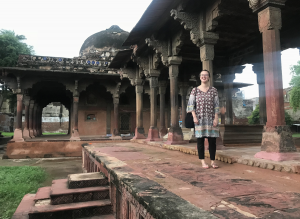
At the Nadan Mahal
I went and looked at the very interesting Sibtainabad Imambara, which is located in the neighbourhood of Hazratgunj. The Sibtainabad Imambara was ordered to be built in 1847 by Wajid Ali Shah, in the year of his coronation. This building was a place of mourning in his times and is even today, after its restoration of the building, and hosts a special ceremony. This building is not just a place for worship. Here the tomb of Amjad Ali Shah. The interior of the building is an extremely beautiful view. On its walls are painted green lines and patterns, very thinly and delicately articulated. Mirrors and chandeliers shine. In the year 1858, soldiers of the British army attacked the Imambara and destroyed the courtyard of the building. After that, in the days of British government, the Imambara became a church. Recently, in 2013, the Imambara was restored.
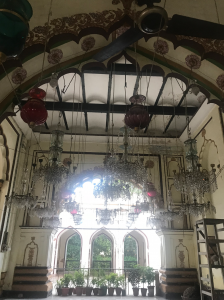
Interior of the Shah Najaf Imambara
Lucknow’s places like these two, which are particular to this city, specially demonstrate its culture of mourning which was built into its unique architecture. Today the age of the nawabs has passed, but these traditions are alive in these places.
